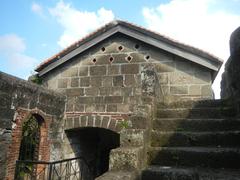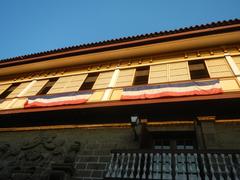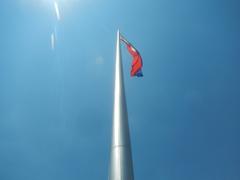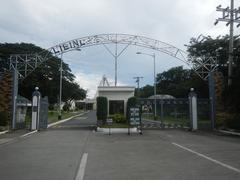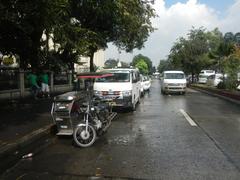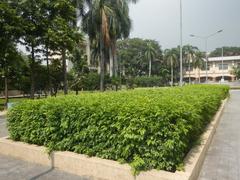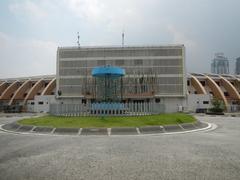Manuel L. Quezon Historical Marker: Visiting Hours, Tickets, and Complete Guide – Taguig, Philippines
Date: 14/06/2025
Introduction
The Manuel L. Quezon Historical Marker in Taguig City is a prominent heritage site commemorating the legacy of Manuel Luis Quezon, the second President of the Philippines and first president of the Philippine Commonwealth. Situated at Plaza Quezon in Sta. Ana, Taguig, this landmark is not only a tribute to Quezon’s pivotal role in nation-building, cultural advancement, and the independence movement, but also serves as a vibrant hub for community engagement and Filipino heritage education.
Whether you are a history enthusiast, a student, a tourist, or a local resident, this guide covers everything you need to know about visiting the marker—from its historical context to practical visitor tips, accessibility, and nearby attractions. For further details, consult resources from the National Historical Commission of the Philippines (NHCP), the Taguig City tourism office, and dedicated heritage guides (ApolloCreates).
Contents Overview
- Historical Background of Manuel L. Quezon
- The Commonwealth Presidency and Nation-Building
- The Quezon Marker: Context and Purpose
- Location, Directions, and Visiting Hours
- Accessibility and Visitor Facilities
- Guided Tours, Events, and Engagement
- Nearby Historical Sites and Attractions
- Visitor Tips and FAQs
- Conclusion and Recommendations
- Sources
Historical Background of Manuel L. Quezon
Manuel L. Quezon (1878–1944) was born in Baler, a town then part of El Principe district. He grew up amidst the Philippine struggle for independence, participating in the Philippine-American War and later pursuing law at the University of Santo Tomas. His political career accelerated as governor of Tayabas, then as Resident Commissioner to the U.S. Congress, and later as the first President of the Philippine Senate. Quezon was instrumental in advocating for Philippine autonomy and shaping the 1916 Jones Law, which expanded self-governance.
The Commonwealth Presidency and Nation-Building
Elected as the first president of the Philippine Commonwealth in 1935, Quezon spearheaded transformative reforms. His leadership prioritised:
- Promotion of the National Language: Quezon established Filipino as the national language, earning the title “Ama ng Pambansang Wika” (Father of the National Language).
- Social Justice and Land Reform: He implemented policies to address inequality, including land redistribution and labor rights.
- Educational Improvements: His administration expanded access to education and modernized the curriculum.
- National Defense: The National Defense Act laid the foundation for a modern military.
- Urban Development: Oversaw the planning and development of Quezon City, envisioned as the future capital.
Quezon’s presidency was defined by his vision for a unified, independent, and progressive Filipino nation.
Leadership During World War II
During the Japanese invasion of the Philippines in World War II, Quezon led the Commonwealth government-in-exile from the United States. Despite his declining health, he worked tirelessly with Allied leaders for the country’s eventual liberation and independence. Quezon passed away in 1944 in Saranac Lake, New York. His remains were repatriated and interred at the Quezon Memorial Shrine in Quezon City.
The Quezon Marker: Context and Purpose
Unveiled by the NHCP in February 2024, the Manuel L. Quezon Historical Marker at Plaza Quezon, Sta. Ana, Taguig, recognizes Quezon’s multi-faceted contributions as a revolutionary, legislator, and president. Written in Filipino, the marker highlights milestones in his career and underscores his enduring impact on Filipino identity, language, and governance. Its prominent location within Taguig’s historical district makes it an accessible focal point for public remembrance and education (NHCP).
Location, Directions, and Visiting Hours
Location:
Plaza Quezon, Sta. Ana, Taguig City, Metro Manila. The marker stands across from the Sta. Ana Archdiocesan Shrine.
How to Get There:
- By Public Transport: Take the MRT to Guadalupe or Ayala stations, then transfer to jeepneys or tricycles bound for Sta. Ana/Plaza Quezon.
- By Private Vehicle: Accessible via C-5 Road or South Luzon Expressway; limited street parking is available around the plaza.
- Jeepneys & Tricycles: Commonly ply routes within Taguig and stop near Plaza Quezon.
- Buses/Ride-Hailing: Buses connect to Bonifacio Global City and adjacent hubs; taxis and apps like Grab and JoyRide offer direct access.
Visiting Hours:
- The Plaza Quezon and marker are open daily from 6:00 AM to 9:00 PM; access is free and no ticket is required.
- While the plaza is open to the public, daytime visits are safer and offer better visibility.
- The nearby Sta. Ana Church typically opens from 6:00 AM to 6:00 PM.
Admission:
- Entrance is free; no tickets or booking are necessary (ApolloCreates).
Accessibility and Visitor Facilities
- Wheelchair Access: Paved walkways and ramps are provided throughout the plaza.
- Restrooms: Public restrooms are located near the main entrance.
- Seating and Shade: Shaded benches and landscaped greenery offer a comfortable environment.
- Parking: Limited street parking nearby; best to visit during off-peak hours.
- Food and Refreshments: Local vendors and eateries offer snacks and beverages around the plaza.
Visitors with mobility concerns should note that while pathways are generally flat, some uneven surfaces may be present. For specific accessibility needs, contact the Taguig City tourism office (HikersBay).
Guided Tours, Events, and Community Engagement
- Guided Tours: While there are no permanent guided tours for the marker, local schools and cultural groups occasionally organize walking tours encompassing Plaza Quezon and nearby landmarks.
- Special Events: The plaza is a hub for community celebrations, especially during “Buwan ng Wika” (August), Quezon Day (August 19), and Independence Day (June 12). These events feature cultural performances, exhibits, and educational workshops (ApolloCreates).
- Heritage Walks: Check local listings or the Taguig tourism office for schedules and availability.
Nearby Historical Sites and Attractions
Taguig offers a wealth of historical and cultural destinations within easy reach of the marker:
- Sta. Ana Archdiocesan Shrine: Historic church with baroque architecture, directly across from Plaza Quezon.
- Felix Y. Manalo National Historical Landmark: Birthplace of the Iglesia ni Cristo founder, notable for its peaceful grounds.
- Parola (Napindan Lighthouse): 17th-century lighthouse significant during the 1896 Revolution.
- Blue Mosque: Architectural and cultural hub for the local Muslim community.
- Veterans Museum: Features World War II exhibits and dioramas.
- Manila American Cemetery and Memorial: Honors WWII American and Allied soldiers (Wanderlog).
- Libingan ng mga Bayani: The National Heroes’ Cemetery, site of annual commemorations.
- St. John the Baptist Parish (Dambanang Kawayan): Notable for its bamboo architecture.
For more details, visit ApolloCreates and Wanderlog.
Visitor Tips and Frequently Asked Questions (FAQs)
Best Time to Visit
- Early mornings and late afternoons (6:00–9:00 AM, 4:00–6:00 PM) are cooler with fewer crowds.
- August (“Buwan ng Wika”) offers special events and cultural exhibits.
Dress Code and Etiquette
- Modest attire is recommended, especially when visiting religious sites.
- Maintain respectful behavior; avoid loud conversations and littering.
- Photography is encouraged, but ask permission before photographing people or during ceremonies.
Safety and Security
- The area is generally safe, with security personnel and community presence.
- Take standard precautions with personal belongings.
Health and Comfort
- Bring water and sun protection, particularly in hot months.
- Use insect repellent during the rainy season.
- Restrooms and shaded seating are available; nearby establishments in Bonifacio Global City offer additional amenities.
Accessibility
- The plaza is wheelchair-friendly but may have some uneven surfaces.
- For special assistance, contact the Taguig tourism office (HikersBay).
Frequently Asked Questions (FAQs)
Q: What are the visiting hours of the Manuel L. Quezon Historical Marker?
A: Open daily from 6:00 AM to 9:00 PM.
Q: Is there an entrance fee or ticket required?
A: No, admission is free.
Q: Are guided tours available?
A: Tours are organized occasionally by local groups, especially during holidays and cultural events.
Q: Is the site wheelchair accessible?
A: Yes, though visitors should be mindful of occasional uneven pavement.
Q: Can I take photographs?
A: Yes, but please be courteous and ask permission before photographing people or ongoing ceremonies.
Conclusion and Recommendations
The Manuel L. Quezon Historical Marker in Taguig is both a solemn tribute to a national hero and a living center of community life. With its accessible location, free admission, and proximity to numerous historical sites, it is an ideal destination for reflection, education, and cultural immersion. Whether you’re seeking a quiet moment to contemplate Philippine history or wish to participate in vibrant community celebrations, Plaza Quezon offers a uniquely enriching experience.
To enhance your visit:
- Download the Audiala app for interactive tours and real-time updates.
- Check local and official websites for event schedules.
- Explore nearby heritage sites to gain a broader understanding of Taguig’s historical tapestry.
For further information and travel planning, refer to the sources below.
Sources and Further Reading
- Unveiling the Manuel L. Quezon Historical Marker in Taguig City – NHCP
- Taguig City Travel Information – HikersBay
- Taguig Landmarks and Historical Sites – ApolloCreates
- Most Historic Buildings and Sites in Taguig City – Wanderlog
- Best Things to Do in Taguig City – Trip101
- Taguig City: Its Historical and Cultural Heritage – Vigattin Tourism
- Mapping Historical Sites & Cultural Heritage – Taguig News

